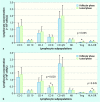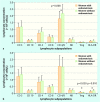Cytotoxic T-Cells in Peripheral Blood in Women with Endometriosis
- PMID: 24771894
- PMCID: PMC3862048
- DOI: 10.1055/s-0033-1350702
Cytotoxic T-Cells in Peripheral Blood in Women with Endometriosis
Abstract
Aim: The etiology of endometriosis remains unknown, but increasing evidence suggests that immune regulation may be important. Our study aimed to evaluate peripheral blood lymphocyte subpopulations during the menstrual cycle in women with peritoneal and ovarian endometriosis relative to healthy women. Methods: In this study, 65 women with endometriosis (37 in the follicular phase and 28 in the luteal phase of the menstrual cycle) and 61 healthy women (33 in the follicular phase and 28 in the luteal phase) were enrolled. Flow cytometric analysis measured peripheral blood lymphocyte subpopulations. The serum levels of cortisol were also determined. Results: In healthy controls, we detected an increased concentration of cytotoxic (CD8+) T cells and activated (HLA-DR) T cells in the luteal phase compared with the follicular phase of the menstrual cycle (p = 0.020 and p = 0.045), whereas no such fluctuation was detected in endometriosis. However, a marked increase in regulatory T-cell concentration in the luteal phase was detected only in endometriosis patients (p = 0.005). Women with endometriosis had higher levels of serum cortisol (p = 0.022), which correlated with the concentration of regulatory T cells (p = 0.048). Conclusions: Women with endometriosis do not exhibit fluctuations in the concentrations of cytotoxic and activated peripheral blood lymphocytes during the menstrual cycle. The marked fluctuation of regulatory T cells detected in endometriosis could be attributed to altered immune response.
Einleitung: Endometriose ist ein häufiges, jedoch komplexes gynäkologisches Syndrom unbekannter Pathogenese, von dem Frauen im gebärfähigen Alter befallen sind. Die Ätiologie der Endometriose bleibt unbekannt, aber immer häufigere Beweise zeigen, dass das Immunsystem dabei eine große Rolle spielt. Unsere Studie zielte darauf ab, die peripheren Blutlymphozytensubpopulationen während des Menstruationszyklus bei Frauen mit Peritoneal- und Ovarialendometriose im Vergleich zu gesunden Frauen zu bewerten. Methoden: Die Studie umfasste 65 Frauen mit Endometriose (37 in der Follikelphase und 28 in der Lutealphase des Menstruationszyklus) und 61 gesunde Frauen (33 in der Follikelphase und 28 in der Lutealphase des Menstruationszyklus). Die Lymphozytensubpopulationen wurden mittels Durchflusszytometrie festgestellt. Der Serumspiegel von Cortisol wurde ebenfalls bestimmt. Ergebnisse: Bei gesunden Probanden fanden wir im peripheren Blut eine erhöhte Konzentration von zytotoxischen (CD8+) T-Zellen und aktivierten (HLA-DR) T-Zellen in der Lutealphase gegenüber der Follikelphase des Menstruationszyklus (p = 0,020 und p = 0,045), während keine solche Schwankung in der Endometriose festgestellt wurde. Ein deutlicher Anstieg der regulatorischen T-Zellen-Konzentration in der Lutealphase wurde nur bei Frauen mit Endometriose ermittelt. Frauen mit Endometriose hatten einen höheren Serumspiegel von Cortisol (p = 0,022), der mit der Konzentration von regulatorischen T-Zellen (p = 0,048) korreliert. Schlussfolgerung: Frauen mit Endometriose zeigen keine Konzentrationsschwankungen von zytotoxischen und aktivierten Lymphozyten im peripheren Blut während des Menstruationszyklus. In der Endometriose nachgewiesene Schwankungen von regulatorischen T-Zellen können auf veränderte Immunantwort zurückgeführt werden.
Keywords: cell immunity; endometriosis; gynecology; infertility; regulatory T cells.
Conflict of interest statement
Figures



Similar articles
-
Fluctuation of peripheral blood T, B, and NK cells during a menstrual cycle of normal healthy women.J Immunol. 2010 Jul 1;185(1):756-62. doi: 10.4049/jimmunol.0904192. Epub 2010 Jun 7. J Immunol. 2010. PMID: 20530263
-
Healthy women and patients with endometriosis show high concentrations of inhibin A, inhibin B, and activin A in peritoneal fluid throughout the menstrual cycle.Hum Reprod. 1998 Sep;13(9):2606-11. doi: 10.1093/humrep/13.9.2606. Hum Reprod. 1998. PMID: 9806293
-
Decrease in activated regulatory T cell populations in the endometrium during ovulation in endometriosis.J Reprod Immunol. 2023 Mar;156:103825. doi: 10.1016/j.jri.2023.103825. Epub 2023 Feb 1. J Reprod Immunol. 2023. PMID: 36758472
-
Higher Circulating Cortisol in the Follicular vs. Luteal Phase of the Menstrual Cycle: A Meta-Analysis.Front Endocrinol (Lausanne). 2020 Jun 2;11:311. doi: 10.3389/fendo.2020.00311. eCollection 2020. Front Endocrinol (Lausanne). 2020. PMID: 32582024 Free PMC article.
-
The effect of the menstrual cycle on exercise metabolism: implications for exercise performance in eumenorrhoeic women.Sports Med. 2010 Mar 1;40(3):207-27. doi: 10.2165/11317090-000000000-00000. Sports Med. 2010. PMID: 20199120 Review.
Cited by
-
Regulation of Inflammation Pathways and Inflammasome by Sex Steroid Hormones in Endometriosis.Front Endocrinol (Lausanne). 2020 Jan 29;10:935. doi: 10.3389/fendo.2019.00935. eCollection 2019. Front Endocrinol (Lausanne). 2020. PMID: 32063886 Free PMC article. Review.
-
Nanoceria as a non-steroidal anti-inflammatory drug for endometriosis theranostics.J Control Release. 2025 Feb 10;378:1015-1029. doi: 10.1016/j.jconrel.2024.12.074. Epub 2025 Jan 3. J Control Release. 2025. PMID: 39742921
-
Blood biomarkers for the non-invasive diagnosis of endometriosis.Cochrane Database Syst Rev. 2016 May 1;2016(5):CD012179. doi: 10.1002/14651858.CD012179. Cochrane Database Syst Rev. 2016. PMID: 27132058 Free PMC article.
-
Altered Glycolysis, Mitochondrial Biogenesis, Autophagy and Apoptosis in Peritoneal Endometriosis in Adolescents.Int J Mol Sci. 2024 Apr 11;25(8):4238. doi: 10.3390/ijms25084238. Int J Mol Sci. 2024. PMID: 38673823 Free PMC article.
-
CD200 and CD200R Expression on Peripheral Blood Lymphocytes and Serum CD200 Concentration as a New Marker of Endometriosis.J Clin Med. 2020 Sep 21;9(9):3035. doi: 10.3390/jcm9093035. J Clin Med. 2020. PMID: 32967175 Free PMC article.
References
-
- Bulun S A. Endometriosis. New Engl J. 2009;360:268–279. - PubMed
-
- Baldi A, Campioni M, Signorile P G. Endometriosis; pathogenesis, diagnosis, therapy association with cancer (Review) Oncol Rep. 2008;19:843–846. - PubMed
-
- Lebovic D I, Mueller M D, Taylor R N. Immunobiology of endometriosis. Fertil Steril. 2001;75:1–10. - PubMed
-
- Nothnick W B. Treating endometriosis as an autoimmune disease. Fertil Steril. 2001;76:223–231. - PubMed
LinkOut - more resources
Full Text Sources
Other Literature Sources
Research Materials

